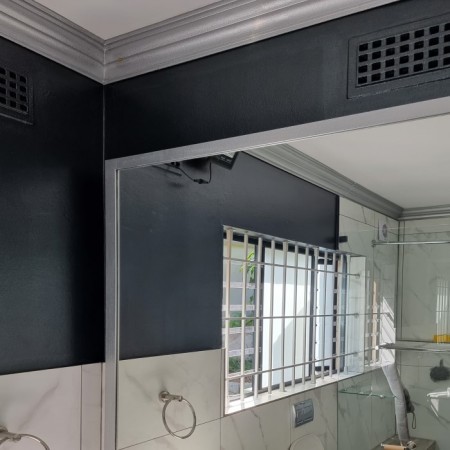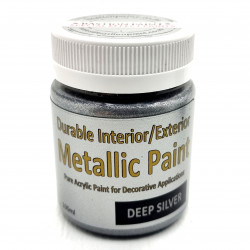Metallic Paint - Aluminium Silver
From
R 132.00
Availability:
- This paint contains only real aluminium metal pigments.
- Painted surfaces look like aluminium metal and the paint also imparts an attractive shimmer.
- Highly durable for interior and exterior applications.
- Super Adhesion paint that can be applied directly to masonry, canvas, plastics, melamine, resins, wall tiles, non-corroding metals, ridged rubbers, most fabrics and interior wood.
Downloads:
Aluminium Silver Paint
The only pigment in this paint is real aluminium powder. This creates a high gloss, metallic aluminium finish with an attractive shimmer.
About this paint
Highly durable paint for interior and exterior applications.
Hard, durable, stain resistant and easy to clean with a glossy, shimmering finish.
Being a water-based paint it can be used on polystyrene cornices. It is also wonderful on plant pots, picture frames, hand rails, balustrades, cupboard doors and can even be used to transform a cheap plastic table into an aluminium table. It is also great in acrylic pours (see video link below). In the photos you will see polystyrene cornices, a wooden mirror frame, old wooden banisters and a cheap plastic table all painted with this Aluminium Silver Paint.
For normal applications this paint is too glossy and shiny for feature wall applications. Higher gloss paints are more difficult to paint walls with as surface defects, roller defects and application defects show up very clearly when using glossy paints. Use our Metallic Paints for Standard Applications, Bright Silver or Deep Silver, for feature walls. Walls do not require a Super Adhesion paint.
This is one of very few water-based aluminum paints manufactured worldwide because fine aluminium powder is explosive when placed in water making these sort of paint very difficult to manufacture.
Enjoy the environmental and health benefits of using water-based metallic paints.
Videos
Take a few seconds to see the beautiful effect of our Aluminium Silver Paint in acrylic pours. Enjoy the shimmering rivers of liquid silver in the fist video.
Fluid Art by Traci Scerri:
(When used in acrylic pouring art, this paint should be mixed with our Metallic Paint Flow Control.)
How our Aluminium Silver Paint differs from our standard Silver Metallic Paints
We also manufacture two other Metallic Silver Paints (see Bright Silver and Deep Silver in our Metallic Paint range). They also contain real Aluminium Pigment but other pigment types as well. This Aluminium Paint only contains real aluminium pigment and is thus more glossy. Being a Super Adhesion product it can be applied to more surface types to give them a real aluminium finish.
This paint is expensive to manufacture but for art or features that require something extra special then this may be just what you need.
Super Adhesion Technology
Pure acrylic paint with Super Adhesion Technology. This paint can be applied directly to masonry, plastics*, melamine, resins, wall tiles**, non-corroding metals***, ridged rubbers, fabrics and interior wood.
- *Lightly sand plastics and resin with a fine sandpaper before painting to enhance adhesion.
- **Do not use on high gloss wall tiles.
- **Non corroding metals include aluminium, galvanised steel, stainless steel copper, bronze and brass.
To prepare this paint for air-spray applications, thin it with our Acrylic Spray Medium (which is also a Super Adhesion product).
To prepare this paint for Acrylic Pouring Art, condition it with our Metallic Paint Flow Control.
Keep out of reach of children
All our products should be kept out of reach of children under 5 years and anybody who may tend to place items or liquids in their mouths should be supervised. Even packing can become a choking hazard.
Unit Size |
|
| Unit Size | |
Unit Size |
|
| Unit Size | |
Colour |
|
| Colour | |
Unit Size |
|
| Unit Size |
110ml
350ml
1 Litre
|







 How to Paint with Metallic Paints
How to Paint with Metallic Paints





